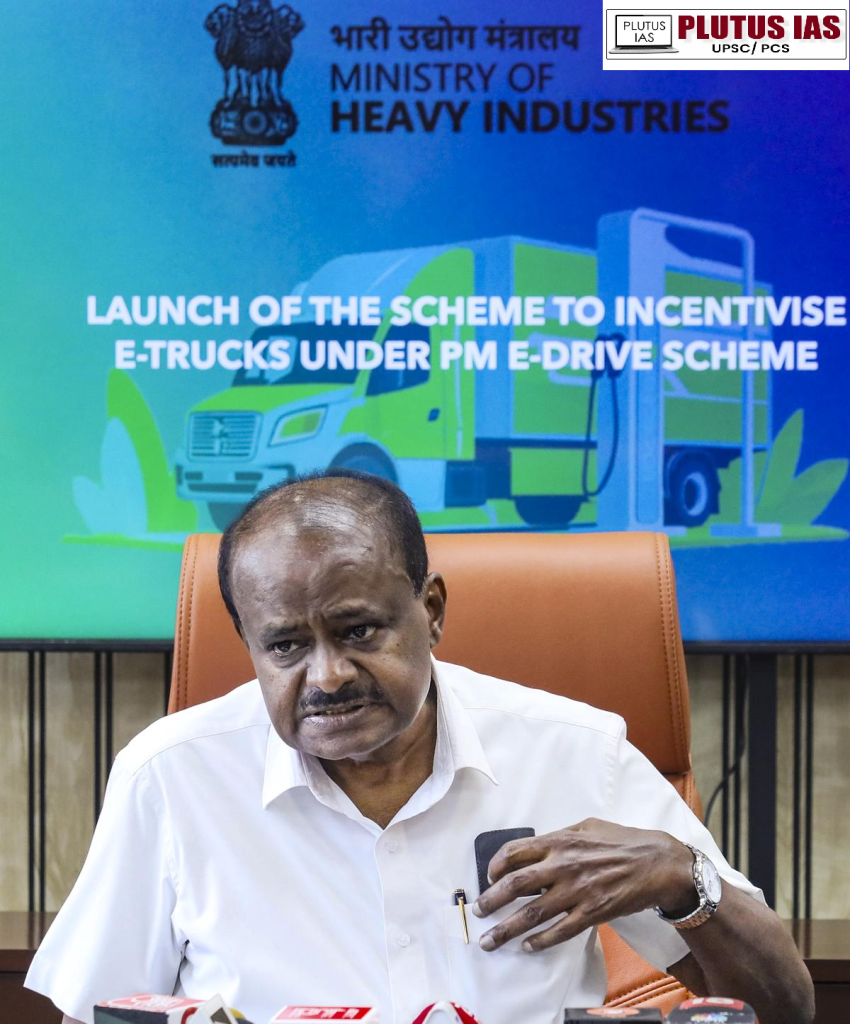Key Features of PM E-DRIVE Scheme
| Category |
Details |
| a. Financial Allocation & Duration |
– Total outlay of ₹500 crore for 5,600 electric trucks
– Scheme valid from Oct 1, 2024 to Mar 31, 2026
– 20% of funds reserved for Delhi-registered trucks |
| b. Eligibility Criteria |
– Battery warranty: 5 years or 5 lakh km (whichever is earlier)
– Vehicle & motor warranty: 5 years or 2.5 lakh km
– Mandatory scrapping of old diesel trucks for availing incentives |
| c. Vehicle-Wise Subsidy Structure |
– Two-wheelers: ₹5,000/kWh (max ₹10,000) in Year 1; ₹2,500/kWh (max ₹5,000) in Year 2
– Three-wheelers: ₹25,000 in Year 1; ₹12,500 in Year 2
– L5 cargo three-wheelers: ₹50,000 in Year 1; ₹25,000 in Year 2 |
| d. e-Voucher System |
– One vehicle per Aadhaar permitted
– e-Voucher auto-generated at sale
– Voucher required for OEM reimbursement of incentives from the government |
| e. Charging Infrastructure Push |
– Promotion of Electric Vehicle Public Charging Stations (EVPCS)
– Focus on cities with high EV penetration and key freight corridors
– Aims to reduce range anxiety and strengthen EV ecosystem |
Integration with Other Schemes
1. Merger of Existing Schemes: Subsumes the Electric Mobility Promotion Scheme (EMPS-2024) to unify efforts under a single framework for EV promotion.
2. Extension of FAME Benefits: Complements FAME I & II by offering financial support to electric trucks, previously excluded from the scheme.
3. Alignment with NEMMP Goals: Supports the National Electric Mobility Mission Plan (NEMMP) aimed at reducing fossil fuel use and promoting EV adoption.
4. Strengthening the Vehicle Scrappage Policy: Reinforces the scrappage ecosystem by mandating scrapping of old diesel trucks to access incentives.
5. Support to Make in India and Atmanirbhar Bharat: Promotes domestic EV and component manufacturing, reducing dependence on imported technologies.
6. Synergy with State EV Policies: Acts as a central booster to various state-level EV initiatives, ensuring coordinated national progress.
7. Contribution to Global Climate Commitments: Reinforces India’s role in global climate action, especially under the Paris Agreement, by pushing for low-carbon freight mobility.
Significance of the Scheme
1. India’s First EV Scheme for Freight Transport: Marks a pioneering effort to electrify heavy-duty transport, filling a major policy void.
2. Targeted Urban Pollution Reduction: Aims to reduce emissions in urban freight corridors, which are major sources of vehicular pollution.
3. Transition from Diesel to Clean Energy: Encourages the shift to electric mobility, cutting down both carbon emissions and noise pollution.
4. Push to Domestic Manufacturing: Strengthens the Make in India initiative by promoting local innovation and MSME participation in the EV sector.
5. Enhancement of Energy Security: Reduces dependence on diesel imports, supporting India’s broader goals of energy self-reliance.
6. Financial Viability for Users: Improves the cost-effectiveness of EV ownership through time-bound demand incentives for trucks and cargo vehicles.
7. Blueprint for Future EV Policies: Establishes a scalable model through innovations like e-vouchers and public charging infrastructure support.
Challenges & Concerns
1. Limited Budget Allocation: The ₹500 crore fund may not be sufficient to make a large-scale impact, especially considering the vast size of India’s commercial freight sector.
2. OEM Readiness & Compliance: Not all Original Equipment Manufacturers (OEMs) may be technologically or financially prepared to offer the required 5-year battery and motor warranties.
3. Charging Infrastructure Deficit: Public EV charging stations are still lacking in Tier-II and Tier-III cities, as well as along major freight highways.
4. Affordability for Small Operators: Even with subsidies, the upfront cost of electric trucks remains high for small fleet operators and individual truck owners.
5. Low Awareness & Digital Divide: Many beneficiaries may not be aware of the e-voucher process or lack digital access to claim benefits smoothly.
6. Battery Supply Chain Issues: Dependence on imported lithium-ion batteries and raw materials could create supply disruptions or cost escalations.
7. Implementation & Monitoring Gaps: Effective on-ground monitoring, disbursal of incentives, and coordination with state transport departments may pose operational challenges.
Way Forward
1. Enhance Budgetary Support: Future Union Budgets should consider scaling up the outlay to expand scheme coverage and extend support to more segments.
2. Promote Private Investment in Charging Stations: Encourage PPP models and private players to build and operate EV public charging stations (EVPCS) across transport corridors.
3. Inclusion of Long-Haul & Inter-State Fleets: Expand the scheme’s scope to cover long-distance logistics operators, including cold chain and bulk carriers.
4. Simplify Access to Incentives: Create a single-window digital platform for e-vouchers and document uploads to make it user-friendly and inclusive.
5. Strengthen Vehicle Scrappage Infrastructure: Expand certified scrapping centres and streamline scrappage procedures to make it easy for truck owners to transition.
6. Support Local Battery Manufacturing: Incentivize indigenous battery production and recycling ecosystems to reduce import dependency.
7. Capacity Building for OEMs & Dealers: Train EV manufacturers, dealers, and local transport offices to ensure compliance with scheme guidelines and effective implementation.
Conclusion
The PM E-DRIVE Scheme represents a significant milestone in India’s electric mobility journey, marking the first targeted effort to electrify the freight and commercial vehicle sector. By subsuming existing schemes and introducing new mechanisms like e-vouchers and focused incentives, the initiative aims to bridge critical gaps in policy, affordability, and infrastructure. While challenges like limited funding, OEM preparedness, and infrastructure bottlenecks persist, the scheme lays a strong foundational framework for cleaner, energy-efficient logistics. If backed by sustained policy support, industry participation, and infrastructure scaling, PM E-DRIVE can emerge as a game-changer in India’s path toward net-zero emissions, urban air quality improvement, and energy self-reliance.





No Comments